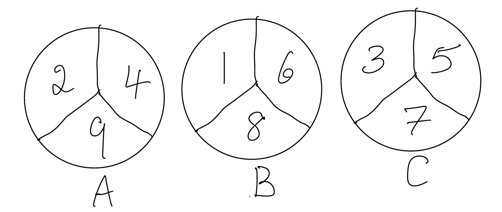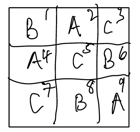Imagine three fair spinners.

If we compare A and B there are 9 equally likely outcomes. The ones where A wins are highlighted.
2-1 2-6 2-8 4-1 4-6 4-8 9-1 9-6 9-8
A beats B 5/9 or about 56% of the time.
if we compare B with C there are 9 equally likely outcomes. The ones where B wins are highlighted.
1-3 1-5 1-7 6-3 6-5 6-7 8-3 8-5 8-7
B beats C 5/9 or about 56% of the the time.
So A beats B most of the time and B beats C most of the time. How will A fare against C? Intuitively we might reason A beats B and B beats C, so A will beat C most of the time too. But not so! C beats A the majority (56% again) of the time. Here's C versus A, C's wins highlighted.
3-2 3-4 3-9 5-2 5-4 5-9 7-2 7-4 7-9
This is a simplified version I made up of something called intransitive dice (Wikipedia), where three dice are numbered in such a way that A will beat B the majority of the time, B will beat C the majority of the time, but when A is pitted against C it is C that has the greater chance of winning. It's also possible to have a longer chain, of four or more dice.
Interesting
If we arrange the numbers 1 through 9 into a 3x3 square and note which numbers are on spinners A, B and C, we find we hey a "Latin square"; each letter appears in each row and each column,

Also note the three numbers on any spinner always sum to 15.
Just for fun I wrote and ran a Python simulation that spins the three spinners a million times and prints out the percentage of the time A beats B, that B beat C and that C beats A, and sure enough I got
A>B 55 %
B>C 56 %
C>A 56 %
Program below
import random
A = [2, 4, 9]
B = [1, 6, 8]
C = [3, 5, 7]
abeatsb = 0
bbeatsc = 0
cbeatsa = 0
trials = 1000000
for go in range(trials):
a = random.choices(A,k=1)[0]
b = random.choices(B,k=1)[0]
c = random.choices(C,k=1)[0]
if a > b:
abeatsb = abeatsb + 1
if b > c:
bbeatsc = bbeatsc + 1
if c > a:
cbeatsa = cbeatsa + 1
print('A>B',round(abeatsb/10000),'%')
print('B>C',round(bbeatsc/10000),'%')
print('C>A',round(cbeatsa/10000),'%')